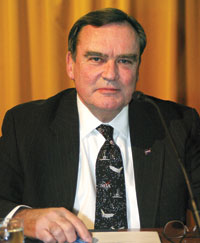Reaching for the Stars
 As the Falcon 9 rocket shot into the sky toward the International Space Station at 3:44 a.m. on May 22, Michael Wholley, LLM '85, watched intently on NASA television streaming on his computer.
As the Falcon 9 rocket shot into the sky toward the International Space Station at 3:44 a.m. on May 22, Michael Wholley, LLM '85, watched intently on NASA television streaming on his computer.
The rocket launch represented the first private-public partnership between billionaire entrepreneur Elon Musk, founder of the SpaceX Co., and NASA. It also was the culmination of seven years of legal work for Mr. Wholley and the legal team at NASA.
"This is a big day for me," the NASA general counsel said, a few hours after the takeoff. "We've been instrumental in developing the legal framework that allowed this to happen. We had to consider what governed commercial spaceflights. We had to structure a process where it would be in the interests of commercial [companies] to partner with NASA."
Space law is a rapidly evolving field full of ethical, political, and economic challenges. But Mr. Wholley decided that in order to fully immerse himself he needed to investigate NASA's beginnings: For inspiration, he mined the Space Act of 1958, the original legislation that created the space agency.
"It was a different time then than now," he says. In the 1950s, "we needed a civil space agency to compete with the Soviet Union. The Space Act that created NASA also gave it 'other transactions' authority to enter into whatever agreements were necessary to further NASA's mission." Those other agreements were the foundation for the NASA legal team's work around the rocket launch.
Falcon 9, built with nine engines, carried to the space station T-shirts and the ashes of Mercury astronaut Gordon Cooper and actor James Doohan, who played Scotty on Star Trek, among 298 other vials of ashes in the Dragon capsule. Eventually, SpaceX plans to build a rocket with 27 engines and hopes to ferry a crew.
"That is the Holy Grail of commercial space," Mr. Wholley says.
In time, the law will become more sophisticated, he says, to iron out who gets what if wealth is made or resources are found in space. The Outer Space Treaty of 1967 sets out that space exploration, including the moon, should be for peaceful purposes to benefit all of mankind.
Mr. Wholley has thought a lot about land-use questions in his career, though in more earthbound settings. Even now at NASA, he and his team of 155 lawyers are negotiating cleanups around contaminated areas from rocket testing, jet fuels, and other hazardous substances, as well as creating buffer zones between the facilities and residents. NASA runs 10 centers around the country, which have all of the land-use concerns associated with large government real estate holdings.
These are similar to the issues he encountered working for the Marine Corps after graduating with highest honors from George Washington University Law School with a master's in environmental law and land use. He holds a BA from Harvard University and a JD from the University of Virginia. His first job after receiving his GW degree was at the Marine Corps Air Station at Cherry Point in North Carolina.
Resorts had grown up around the base since it had been built during WWII, when only prop planes flew in and out of this thin spit of land. Mr. Wholley worked with neighbors concerned about nighttime landings of fighter jets and with fishermen worried about radiation from the planned, and subsequently expanded, Mid-Atlantic Electronic Warfare Range.
His experience at GW informed his work. "Every military base has a number of land-use problems, from environmental to hazardous materials to endangered species," he says. "I was in the Marine Corps [before GW]. I knew I was going to be the resident legal adviser to a large installation in my career, so I believed that getting a graduate degree in environmental law and land use was a skill set that mattered both to my employer and to me."
And after a second master's in national security and strategic studies from the College of Naval Warfare in 1989, Mr. Wholley was assigned to the Marine Corps Base Quantico in Virginia. "There were myriad environmental and land-use issues on this large parcel of land," he says, "ranging from an antiquated water supply and wastewater treatment infrastructure to continued encroachment on federal lands that ran the gamut from dumping hazardous materials to unauthorized burials!"
After retiring from the Marine Corps in 1996, he served as executive director of the Marine Corps Scholarship Foundation until joining NASA in 2004.
Mr. Wholley is far from GW's only link with NASA. GW Law interns have spent summers working for NASA, and NASA in turn has sent visiting scholars to GW. Additionally, GW Law School has historically participated in an international moot court on space, and NASA has been an active sponsor.
For Mr. Wholley, the legal and intellectual journey with the NASA-Space X partnership has been fascinating. "Being a general counsel in an organization like NASA isn't just about practicing law in myriad areas; it is about leadership," he says. "As NASA moves forward in helping to create and foster a space economy with the United States in the lead, we in the legal community are facilitating the next technological breakthroughs and ensuring that NASA is an engine of innovation for the American economy."
—Laura Hambleton
